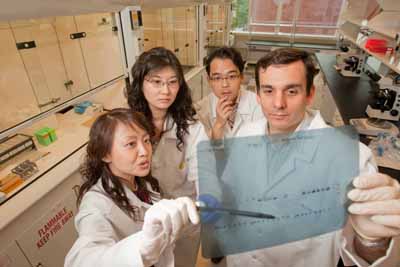Hormone researchers at the University of Houston (UH) have their sights set on providing
long-term treatment options for diabetes, obesity and cardiovascular diseases by better
understanding estradiol, the most potent naturally occurring estrogen.
They now believe that this estrogen hormone is a prominent regulator of several body
functions in both females and males. While estradiol is more commonly associated with
processes and diseases specific to women, the team determined that the hormone actually
functions as a unisex hormone with multiple actions. Research has indicated that when
there is an excessive or insufficient amount of estradiol present, the metabolic network
becomes imbalanced, which can result in metabolic diseases.
“Female hormones have always been associated with the menstrual cycle, pregnancy,
breast-feeding and some diseases, such as osteoporosis and breast cancer, typically
associated with women,” said Dr. Rodrigo Barros, a research assistant professor with
the UH Center for Nuclear Receptors and Cell Signaling (CNRCS). “Our group, however,
has discovered that one of these hormones, estradiol, has much wider actions than
previously thought. It is no longer considered exclusively a ‘female sex hormone,’
but a ‘unisex hormone’ with multiple actions across several organ systems.”
Working with CNRCS director and professor Dr. Jan-Åke Gustafsson, Barros says that
part of their research is dedicated to understanding how estradiol regulates feeding
and food metabolism, explaining that this hormone is involved with several metabolic
diseases, including eating disorders, obesity and diabetes.
“We believe that all the systems in the body involved with food consumption and metabolism,
which include the brain, liver, pancreas, heart, muscles and fat, are connected by
estradiol, resulting in a ‘metabolic network’ regulated by the hormone,” Barros said.
“Our evidence shows that when too much or too little estradiol is available, this
delicate network loses its balance and metabolic diseases set in.”
This research has important implications for the average consumer, as well as for
physicians. While hormones like estradiol are important for the adequate maintenance
of body functioning, they may pose serious risks to a person’s health if misused as
supplements. This comes into play when people use alternative forms of hormones, such
as natural plant derivatives, that may be harmful if used inappropriately.
For specialists dealing with hormonal treatments, this research underscores that they
should be aware that several organs and body functions are affected when estradiol
is prescribed and may cause or worsen metabolic diseases. Due to the number of organs
and functions affected by fluctuating levels of estradiol, its use as a hormonal treatment
for patients with delayed puberty, menopausal symptoms, osteoporosis and prostate
cancer is a source of debate within the medical and research communities. Exploring
the impact of such treatments as reported by Barros and Gustafsson is helpful for
keeping these professionals abreast of new research and guidelines.
Their findings are described in an invited review titled “Estrogen Receptors and the
Metabolic Network.” The report appeared in the September issue of the research journal
Cell Metabolism, a high-impact monthly research journal in the Cell Press publishing
network that chronicles notable research on salient scientific discoveries. To view
the abstract, visit http://www.cell.com/cell-metabolism/abstract/S1550-4131%2811%2900312-3.
Funded by the Robert A. Welch Foundation, the Emerging Technology Fund of Texas and
the Cancer Prevention and Research Institute of Texas, the CNRCS team works in collaboration
with Sweden’s Karolinska Institutet.
###
Editorial Note: High-resolution photos of Rodrigo Barros in the lab are available
to media by contacting Lisa Merkl.
About the University of Houston
The University of Houston is a Carnegie-designated Tier One public research university
recognized by The Princeton Review as one of the nation’s best colleges for undergraduate
education. UH serves the globally competitive Houston and Gulf Coast Region by providing
world-class faculty, experiential learning and strategic industry partnerships. Located
in the nation’s fourth-largest city, UH serves more than 38,500 students in the most
ethnically and culturally diverse region in the country.
About the College of Natural Sciences and Mathematics
The UH College of Natural Sciences and Mathematics, with 181 ranked faculty and approximately
4,500 students, offers bachelor’s, master’s and doctoral degrees in the natural sciences,
computational sciences and mathematics. Faculty members in the departments of biology
and biochemistry, chemistry, computer science, earth and atmospheric sciences, mathematics
and physics conduct internationally recognized research in collaboration with industry,
Texas Medical Center institutions, NASA and others worldwide.
About the UH Center for Nuclear Receptors and Cell Signaling
Established in 2009, the University of Houston Center for Nuclear Receptors and Cell
Signaling (CNRCS) is the centerpiece of the university’s tier-one biomedical research
initiative and member of the internationally renowned Texas Medical Center. Working
from the center’s state-of-the-art labs, CNRCS researchers combine interdisciplinary
research with dynamic collaboration within the medical center and with industry partners,
with the goal of finding new treatments for an array of significant diseases, including
cancer, diabetes and metabolic syndrome. To learn more, visit http://cnrcs.uh.edu.
For more information about UH, visit the university’s Newsroom.
To receive UH science news via e-mail, sign up for UH-SciNews.
For additional news alerts about UH, follow us on Facebook and Twitter.
